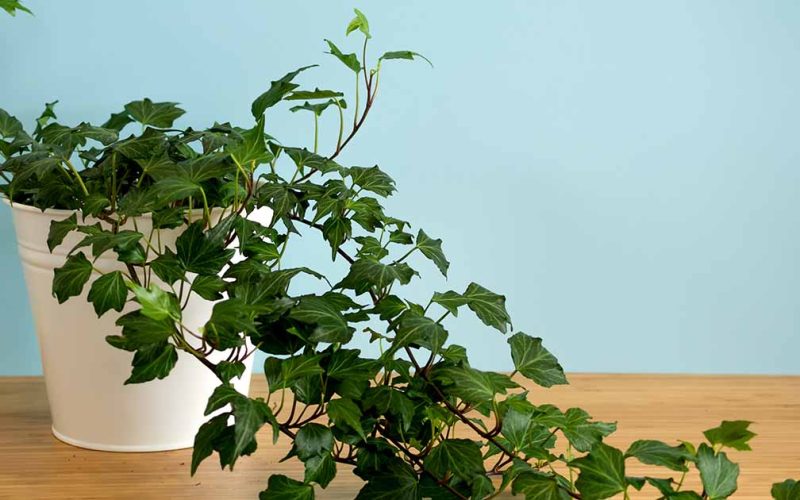Few houseplants are as versatile as ivy, so it makes sense that they’re often one of the most commonly purchased plants.
They’re so easy to care for that they make great starter plants and can easily be cultivated by even the newest hobbyist.
But that doesn’t mean there aren’t some things to watch out for when you care for your ivy houseplant.
And that’s why we put together this comprehensive guide on how to care for an ivy houseplant. Follow these steps, and you should be good to go!
Ivy Houseplant – A Botanical Evaluation
(Ivy houseplant) Hedera Helix, if you’re feeling fancy, is a popular indoor foliage plant. It is often used as an evergreen ground cover and can be clipped to a specific shape and size.
It’s a family of shrubs and vines native to Europe, Asia, Africa, and Australia. Some species grow up to 50 feet tall!
As a general rule of thumb, healthy Ivy plants should have evenly spaced leaves on long stems.
The Different Kinds of Ivy Houseplants
Most ivy plants you’ll come across are technically English ivy (Hedera helix), but many varieties of Hederas exist.
Each variety’s color and growth patterns will differ, but in most cases, so will their care. What works for one type of Hederas won’t work for another.
If you want your ivy houseplant to thrive and be healthy, it’s a good idea to know what kind you have first. Luckily, there are general guidelines that cover all types of ivy.
Here is a list of the types of ivy plants:
Japanese Climbing Ivy (Parthenocissus tricuspidata)
This type of ivy can grow up to 40 feet long, so ensure you have something sturdy enough to support it! It requires little sunlight and prefers moist soil.
English Ivy (Hedera Helix)
It is a common indoor/outdoor vine often used as a ground cover or hanging basket. It can tolerate full sun or partial shade, though too much sunlight can burn its leaves.
Variegated English Ivy (Hedera Helix ‘Variegata’)
Also known as Grecian ivy, variegated ivy has green leaves with white stripes. Variegated ivies prefer shade and cool temperatures.
Grape-leafed Ivy (Cissus Rombifolia)
Also known as parlor palm, grape-leafed ivy grows upright instead of trailing along like other kinds of vines. Its leaves resemble grapevines, which is where it gets its name.
Creeping Charlie (Pileostegia Venusta)
Creeping Charlie isn’t an Ivy; rather, it’s part of the Carpet Vine family. However, it’s still commonly referred to as an ivy because of its similar appearance and growing habits.
Virginia Creeper (Parthenocissus Quinquefolia)
Virginia creeper is a woody vine that grows quickly, perfect for covering fences or walls. As with other types of ivy, it can tolerate sun and shade.
How to Develop Ivy Houseplant
To keep a houseplant healthy, you must understand what it likes and doesn’t like. Ivy is one of the most popular plants for new gardeners.
They’re easy-care plants that require a little water and sunlight but can be killed by overwatering or too much sunlight. Read on to learn more about caring for ivy houseplants.
Choose the Right Soil
You have a few options when choosing what soil to use with ivy plants. In truth, you can use any potting mix available.
However, you’ll probably want something rich in nutrients and good drainage so your plants will thrive.
A well-draining potting mix allows air into your plant’s roots, helping them to breathe. Since ivy houseplant is prone to root rot (especially when over-watered), ensuring your plant has a healthy growing environment is very important.
The Proper Sunlight
The best way to care for a pothos ivy is by placing it in direct sunlight. Although it can grow well with indirect sunlight, your ivy will thrive if you get enough sunlight through windows or skylights.
You must never place your pothos under direct sun rays between 10 am and 2 pm as these will damage its delicate leaves.
Try placing a sheer curtain over your windows so they still receive plenty of natural light, but you’re protected from harsh UV rays.
Once placed in a sunny spot, move any other plants around your ivy houseplant out of direct sunlight. They could become damaged if left out in those conditions.
Proper Watering
Proper watering is key for houseplants. Overwatering can lead to root rot, and underwatering can cause wilting and stunted growth.
The best way to determine how often your ivy houseplant needs watering is by keeping an eye on its soil. And give it a long drink when it’s just beginning to dry out.
In addition, be sure that you’re placing your plant in a well-lit area. Ivies love natural sunlight and will do much better with consistent access than with fluorescent lighting alone.
Proper Moisture and Temperature
Although some varieties of ivy are drought-tolerant, many do best when they receive regular water.
The best way to water your plant is with a soaker hose in the garden or a sink sprayer indoors. Always allow the soil to dry out slightly between watering periods.
However, if you notice your ivy’s leaves turning brown, you’re likely overwatering it.
The ideal temperature range for most varieties of ivy is between 60 and 80 degrees Fahrenheit (16 and 26 Celsius).
If direct sunlight is too strong in warmer weather, move your ivy houseplant outdoors or into a shady area for relief. Just be sure not to leave it in the full sun all day.
Fertilizer
To keep your ivy houseplant looking healthy and green, giving it plenty of light and nutrients is important. Fertilizer helps keep your plants alive and can promote growth.
However, different types of fertilizer work best depending on how you’re growing your houseplant.
For example, chemical fertilizers are toxic, while organic fertilizers may contain bacteria that stunt plant growth in various ways. Ensure you have all the information you need when picking a fertilizer plan.
Care and Maintenance of Ivy Houseplant
As an evergreen, ivy prefers low light and good air circulation. If you keep those things in mind, providing ivy with its needs is easy. That said, like any plant, there are some exceptions.
If your local weather is hot and humid, you’ll need to care for an ivy differently than if your area is cold and dry.
But regardless of where you live or when your winter months are freezing over with snow (or not), caring for an ivy houseplant is a simple process. Above all, it doesn’t take much time or energy at all.








